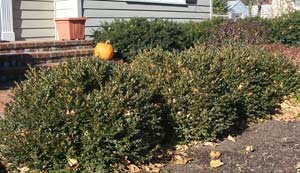Boxwood – Pruning, Winter Care and Fertilizing
 This shrub all often used in mass or as a hedge but their care can be the same if used as a specimen. Pruning should be done in early spring before leafing out. Shear or prune outer branch tips to shape and reduce size. Repeat pruning through summer as needed. For best results pruning should start when the plant is young and stayed with year to year. As the plant matures pruning or shearing can shift to early Summer after the new growth has matured. With rather dense hedges pick pruning should also be done to increase the longevity of the plant. This is done by cutting small holes in the surface of the hedge to let light into the interior of the plant and promote inside budding. This allows you to shear the plants for a longer time without letting the plants get too large.
This shrub all often used in mass or as a hedge but their care can be the same if used as a specimen. Pruning should be done in early spring before leafing out. Shear or prune outer branch tips to shape and reduce size. Repeat pruning through summer as needed. For best results pruning should start when the plant is young and stayed with year to year. As the plant matures pruning or shearing can shift to early Summer after the new growth has matured. With rather dense hedges pick pruning should also be done to increase the longevity of the plant. This is done by cutting small holes in the surface of the hedge to let light into the interior of the plant and promote inside budding. This allows you to shear the plants for a longer time without letting the plants get too large.
This plant grows and develops best in acidic soil. Most of the soil, all of the rainwater and all of the ground water in southeastern Wisconsin is basic or alkaline. Therefore, for some plants to thrive, they need to have special care.
Initially, the soil the plant is installed into should be amended to make it more acidic and to increase the amount of organic matter in the soil. Over time, the soils acidity should be supplemented with an acid-based fertilizer. A liquid fertilizer, Miracid works well. This liquid fertilizer is mixed with water and applied the same as you would water the plant (see product for specific details). This type of fertilization should be done three or four times per year, starting in April and ending by the mid-July. Soil can also be acidified with soil sulfur, aluminum sulfate or cotton seed meal, however, these products will not fertilize the plant. Mulch is also important to acid loving plants. A 2-4″ thickness of bark or needle mulch should surround the plant at least as far out as its drip line.
These evergreens will perform well through most winters. In severe winters, however, they may discolor, but will bounce back in spring. Winter protection may be needed, however, for the first few years after installation, or if the plant has been under stress. To protect the plant, spray it with an anti-transpirant (such as Wilt-Pruf) in mid to late November. The timing for this application can be somewhat tricky. The temperature must be above 40 degrees, and it cannot rain on the plant after the product has been applied. The plant can also be protected by wrapping it in burlap, or enclosing it in a burlap tent. This form of protection will keep the wind and sun off, but will not cut off air flow or trap heat, which can be harmful to the plant. A burlap tent is made by setting three wooden stakes into the ground around the plant and stapling burlap to it on all three sides. The top of this tee-pee like structure should be left open. If the plant is in open soil it should be mulched and get a good watering in early November if the soil is dry. Watering in late fall is very important for the winter health of any evergreen and should be done to young plants every year in early November. Even more mature plants can benefit from late season waterings, especially after a dry fall season.
